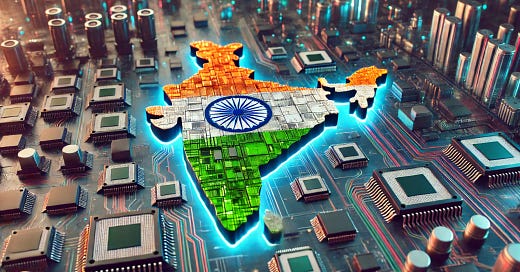#8: India's Semiconductor Ambitions: Crafting a Chip-Powered Future
Imagine Noida’s bustling electronics manufacturing hub producing cutting-edge smartphones, laptops, and EVs, all powered by Made in India semiconductor chips.
Picture a sprawling semiconductor fabrication plant in Gujarat’s Dholera, attracting global tech giants and fostering a thriving ecosystem of semiconductor design and manufacturing companies.
Envision India as a self-reliant semiconductor powerhouse, reducing its dependence on imports and contributing to global supply chains.
It’s all falling in place today.
..
In this edition of India Multipliers, we delve into India's semiconductor aspirations, the initiatives driving this growth, and the challenges and opportunities that lie ahead.
The country has a large and growing domestic market for electronics, a skilled workforce, and a government committed to fostering a conducive environment for semiconductor manufacturing.
As a result, we are witnessing unprecedented interest from major players to invest in the space here.
Tatas are building a fullsome fab and an OSAT plant
And Micron is building one of its most advanced and largest ATMP plants
CG Power is also building an OSAT facility
And many more such mega projects are presently in the pipeline.
..
Several factors are propelling these semiconductor ambitions in India:
Semiconductor Shortage: The recent global semiconductor shortage has highlighted the vulnerability of supply chains and the need for diversification. India sees this as an opportunity to establish itself as a reliable and alternative source of semiconductor chips.
Government Initiatives: The Indian government has launched several initiatives to incentivize semiconductor manufacturing, including the $10bn Semicon scheme which has already been exhausted. It offers financial incentives to companies that invest in semiconductor manufacturing in India. And it’s widely expected that as Modi Govt has returned to power, it will bring a bigger follow-on scheme to attract more such mega investments.
Growing Demand for Electronics: The demand for electronic devices is surging in India, driven by factors such as rising disposable incomes, digital transformation, and government initiatives like Digital India and PLI schemes for electronics manufacturing. This creates a huge domestic market for semiconductor chips.
Strategic Importance: Semiconductors are critical components in a wide range of industries, including electronics, automotive, aerospace, and defence. Developing a domestic semiconductor industry is therefore of strategic importance for India's economic and national security.
..
The India Semiconductor Mission
In its second term in office, PM Narendra Modi’s Government launched the India Semiconductor Mission (ISM) to drive the growth of the semiconductor industry in the country.
For ease, it’s also commonly known as the $10bn SEMICON programme.
The mission aims to:
Attract Investments by offering incentives and creating a favourable business environment.
Develop Necessary Infrastructure for semiconductor manufacturing, including fabrication plants, testing facilities, and research and development centers.
Foster Innovation and encourage R&D in semiconductor technologies to create a strong intellectual property base in India.
Build Talented Workforce for the semiconductor industry through training programs, partnerships with academic institutions, and industry-academia collaborations.
..
However, it’s not all as easy.
While India's semiconductor ambitions are laudable, several challenges lie ahead:
Semiconductor manufacturing is a capital-intensive industry, requiring significant investments in infrastructure and technology. Attracting large-scale investments is crucial, and the only way for India's semiconductor success.
Semiconductor manufacturing is a complex process that requires advanced technology and expertise. India needs to build a strong technological base and attract global talent to compete in this industry.
The semiconductor industry is dominated by a few established players, and India faces stiff competition from countries like the US, Germany, China, Taiwan, Japan and South Korea, who have all announced massive incentives and support packages to attract the best and biggest of these investments.
..
Despite these challenges though, the opportunities for India in the semiconductor industry are immense.
By leveraging its strengths in talent, cost-competitiveness, and a growing domestic market, India can emerge as a major player in this critical sector.
What helps is that even though India is not a big name in semiconductor manufacturing today, it already is a massive contributor to the global semiconductor design ecosystem.
Almost every major player has armies of thousands of talented and experienced professionals in India, working for their global ascent.
..
At Dexter, we recognize the strategic importance of the semiconductor industry for India's economic growth and technological advancement.
We believe that India has the potential to become a global semiconductor hub, contributing to global supply chains and driving innovation in this critical technology.
Share your thoughts in the comments below!
Best,
..
PS: We at Dexter Ventures ($50k-$500k early-stage investments) and Dexter Capital (advise $3MM-$100MM) are always eager to work with like-minded founders, angels and other members of the PE/VC/Family Office ecosystem.
Do reach out to us at deals@dexter.ventures keeping anuradha@dexter.ventures in CC if there is anything we can help you with :)




